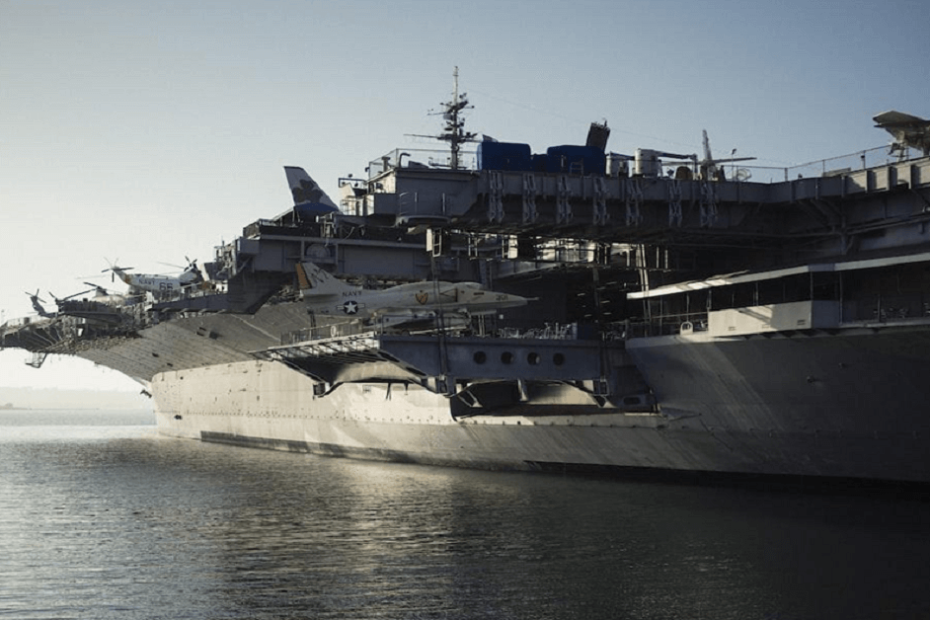In the vastness of the ocean’s expanse, U.S. aircraft carriers stand as symbols of military might and technological prowess. These colossal vessels are not only pivotal in projecting power but also in sustaining peace through deterrence. Aircraft carriers aren’t cheap.
Even the older Nimitz-class ones that have been in use since 1975 cost about $8.5 billion a piece. The newest Gerald Ford-class ones are even more expensive, at $13.3 billion.
Those costs may seem astronomical, but there’s a reason for them. Aircraft carriers have extensive defensive measures that help them stay safe at sea. In this article, let us explore some of the many defense systems that keep these leviathans safe.
State-of-the-Art Defensive Weaponry and Detection
Protection for an aircraft carrier is a complex, layered strategy that incorporates cutting-edge technology and weaponry. It is a comprehensive suite designed to safeguard these valuable assets against an array of threats from above, below, and on the surface of the sea.
Every aircraft carrier is equipped with an array of radar systems. The SPY-1D radar, part of the Aegis Combat System on U.S. Navy carriers, is a state-of-the-art phased array radar that has the capability to perform search, track, and missile guidance functions simultaneously with a very high degree of accuracy.
Alongside surface-search radars, these systems can detect a variety of threats, ranging from low-flying, high-speed missiles to stealth aircraft, providing ample time for the carrier to react.
At the heart of close-range defense is the Phalanx CIWS, an automated system that can detect, track, and engage incoming threats with a high rate of fire. For longer-range engagements, carriers are equipped with various missile systems, such as the RIM-116 Rolling Airframe Missile (RAM) and the RIM-162 Evolved SeaSparrow Missile (ESSM), which are designed to intercept anti-ship missiles and aircraft.
Electronic Warfare: Jamming and Deception Tactics
In addition to physical munitions, electronic warfare systems play a key role in a carrier’s defense. The U.S. Navy is advancing its capabilities with a suite of new electronic defense systems, including lasers. The 2023 budget proposal prioritized development under the Navy Laser Family of Systems. This includes the High Energy Laser with Integrated Optical-dazzler and Surveillance (HELIOS) system.
Seven companies have been contracted under a five-year, $75 million agreement to produce and deliver high-energy laser prototypes. This tells you a little bit about the scale and investment the Navy is making in these technologies.
Advanced Fire Control Systems
Fires can be devastating on ships, and aircraft carriers have several protective countermeasures. Automated fire suppression systems aboard aircraft carriers are sophisticated and crucial for controlling and extinguishing fires, especially in highly volatile environments where fuel and ordnance are present.
The two primary automated systems are the High-Expansion Foam (HEF) system for hangar bays and the Aqueous Film-Forming Foam (AFFF) system for flight decks. The AFFF system is designed to quickly suppress flammable liquid fires, such as jet fuel spills.
AFFF is stored in large tanks, often mixed with water in a concentrate. When activated, the AFFF concentrate is released into a proportioner that mixes it with seawater. On the flight deck, AFFF is delivered through a series of nozzles embedded in the deck surface, ensuring rapid and widespread coverage.
While the foam is highly effective at putting out fires, it is also toxic to humans. Cancer is a common side effect of exposure, and several veterans have considered filing AFFF lawsuit Navy cases.
AFFF is used everywhere, not just in the Navy. TruLaw notes one incident where a former Air Force firefighter alleged his prostate cancer was due to exposure to AFFF.
Due to these safety concerns, there is a significant push to find safer alternatives. The military has set a deadline that prohibits the use of fluorinated AFFF at military installations on or after October 1, 2024, or earlier if the Secretary determines compliance with this prohibition is possible.
This aligns with the new MILSPEC (Military Specification) issued on January 31, 2023, which dictates that any new foam purchased must contain less than 1 part per billion of PFAS chemicals.
Collaborative Safety Through Carrier Strike Groups
Successfully safeguarding an aircraft carrier goes beyond the hardware and electronic wizardry; it encompasses a set of well-thought-out operational strategies and tactics that involve every element of the Carrier Strike Group (CSG). This ensures a multidimensional defense posture capable of countering threats from all vectors.
This assembly of vessels includes destroyers equipped with Aegis missile defense systems, cruisers with advanced anti-aircraft capabilities, and submarines with stealth and strike power.
Together, they form a protective bubble around the carrier. Each unit within the group brings different capabilities to the table, creating a 360-degree defensive net.
Moreover, the fighter jets on board can be quickly launched to ensure air dominance and protect the carrier from enemy air attacks.
Conclusion
In the theater of naval operations, U.S. aircraft carriers remain beacons of strength and security in an unpredictable world. For the families and friends of those aboard an aircraft carrier, it’s natural to feel concerned about their loved ones given the high-stakes environment they operate in.
However, these carriers are not just equipped to project power; they are meticulously crafted to safeguard their crew.
